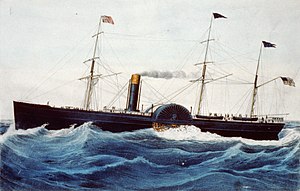SS Baltic (1850)

Baltic
|
|
| History | |
|---|---|
| Name: | Baltic |
| Namesake: | Baltic Sea |
| Operator: | Collins Line |
| Route: | New York-Liverpool |
| Builder: | Brown & Bell, New York |
| Cost: | ~$750,000 |
| Launched: | 5 Feb 1850 |
| Maiden voyage: | 16 Nov 1850 |
| In service: | 16 Nov 1850 |
| Out of service: | 1880 |
| Refit: | As a sailing ship, 1870 |
| Honors and awards: |
Blue Riband holder, 16 Aug 1851–29 Apr 1856 |
| Fate: | Scrapped, 1880 |
| General characteristics | |
| Type: | Passenger |
| Tonnage: | 2,723 gross tons |
| Length: | 282 ft |
| Beam: | 45 ft |
| Depth of hold: | 24 ft |
| Propulsion: | 2 × 500 hp, 96-inch bore, 10-foot stroke single-cylinder side-lever steam engines |
| Speed: | 13 knots |
| Capacity: | Passengers: 200 1st class, 80 2nd class |
SS Baltic was a wooden-hulled sidewheel steamer built in 1850 for transatlantic service with the American Collins Line. Designed to outclass their chief rivals from the British-owned Cunard Line, Baltic and her three sister ships—Atlantic, Pacific and Arctic—were the largest, fastest and most luxurious transatlantic steamships of their day.
Less than a year after entering service, Baltic captured the coveted Blue Riband in 1851 for fastest transatlantic crossing by a steamship. She set a new record again in 1854, and was to remain the fastest steamship on the Atlantic for almost five years. In spite of these record-breaking achievements however, her Collins Line owners continued to lose money, and were eventually bankrupted in 1858.
Baltic subsequently operated as a coastal steamer along the East Coast of the United States, and later served as a transport for the Union cause during the American Civil War before briefly returning to transatlantic service. In her final years she was converted into a sailing ship. Baltic was scrapped in 1880.
For several decades prior to the 1840s, American sailing ships had dominated the transatlantic routes between Europe and the United States. With the coming of oceangoing steamships however, the U.S. lost its dominance as British steamship companies, particularly the government-subsidized Cunard Line, established regular and reliable steam packet services between the U.S. and Britain.
In 1847, the U.S. Congress granted a large subsidy to the New York and Liverpool United States Mail Steamship Company for the establishment of an American steam packet service to compete with Britain's Cunard Line. With this generous subsidy in hand, the New York and Liverpool S.S.C ordered four new ships from New York shipyards and established a new shipping line, the Collins Line, to manage them. The Collins Line ships were specifically designed to be larger and faster, and to offer a greater degree of passenger comfort, than their Cunard Line counterparts. Design of the ships was entrusted to a noted New York naval architect, George Steers.
...
Wikipedia
